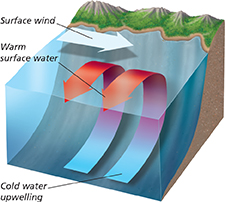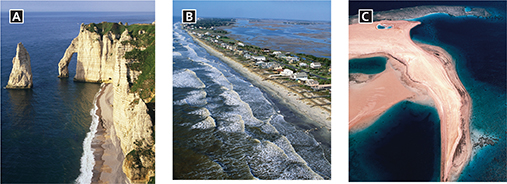Figure 29 Upwelling of deeper ocean water occurs along some coastlines.
Relating Cause and Effect Why are areas of upwelling often excellent areas for commercial fishing?
 d
dFigure 30 Waves produce distinctive geological features.
A A sea cliff with a sea stack and arch in Etretat, France B A barrier beach in South Carolina C A sand spit along the Red Sea in Egypt
 d
dUpwelling
At certain places in the oceans, water from the deep ocean moves upward toward the surface. The movement of water from the deep ocean to the surface is called upwelling. Much upwelling occurs along the western coasts of continents.  In upwelling, winds blow warm surface water aside. This allows cold water from the deep ocean to rise and take the place of the warmer water. You can see how upwelling works in Figure 29. Another major area of upwelling lies along the equator. Here, currents and winds pull surface water on both sides of the equator toward the poles. Upwelling occurs in the strip of ocean where the surface currents move apart.
In upwelling, winds blow warm surface water aside. This allows cold water from the deep ocean to rise and take the place of the warmer water. You can see how upwelling works in Figure 29. Another major area of upwelling lies along the equator. Here, currents and winds pull surface water on both sides of the equator toward the poles. Upwelling occurs in the strip of ocean where the surface currents move apart.
Upwelling brings nutrients from deep in the ocean to the surface. The nutrients support large populations of algae, which serve as food for tiny ocean animals. These animals, in turn, are eaten by fishes. Areas of upwelling often support large populations of fishes and whales.
Wave Erosion and Deposition
Waves can pound a coastline with a tremendous amount of energy. So it's not surprising that waves are the major cause of erosion along coastlines. On a rocky coast, wave erosion creates cliffs, arches, caves, and tall rock towers called sea stacks, as shown in Figure 30.  Two physical processes, hydraulic action and abrasion, are responsible for much wave erosion. Over time, wave erosion and deposition work together to straighten a coastline.
Two physical processes, hydraulic action and abrasion, are responsible for much wave erosion. Over time, wave erosion and deposition work together to straighten a coastline.
How Waves Cause Erosion
The process of hydraulic action occurs when waves pound on cracks in rocks. First, a wave fills a crack with water. Before the water drains from the crack, another wave forces more water into the crack. This pressure causes the crack to get bigger. Waves also compress air as they slam into a cracked rock. This compressed air contributes to wave erosion. Eventually, the rock breaks apart into smaller pieces that are further eroded by waves. Abrasion also breaks up rocks into smaller pieces. The sediment carried by waves acts like sandpaper, rubbing away at the rocks.




